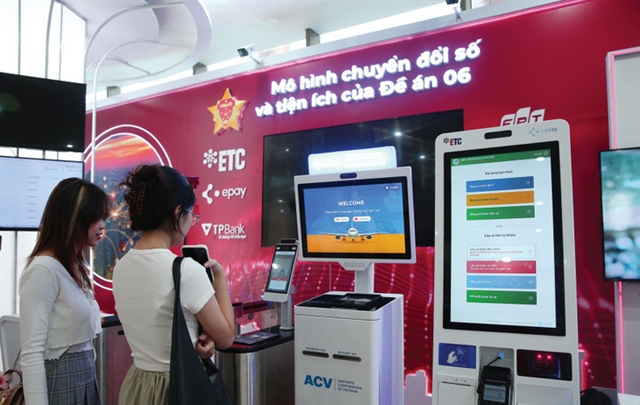 Business Beat
Business Beat


|
| A customer at a Bắc Á Bank transaction office in Hà Nội. The State Bank of Vietnam on October 25 raised its policy rates by 100 basis points, the second increase in a month.— VNA/VNS Photo |
HÀ NỘI — Though the State Bank of Việt Nam (SBV) has hiked interest rates twice in a month, experts agreed the SBV has no other choice but to take strong measures to curb upward pressure on the USD/VNĐ exchange rate and inflation.
The SBV on October 25 raised its policy rates by 100 basis points, the second increase in a month, as it made the first hike with the same rate on September 23. Accordingly, the refinancing rate is 6 per cent per year, up from 5 per cent, while the rediscount rate is 4.5 per cent per year, up from 3.5 per cent.
The SBV said global inflation remains high and the US Federal Reserve (Fed) had raised its rates five times recently, with more hikes expected this year and in 2023. Besides, the strengthening of the dollar has put pressure on domestic interest rates and the exchange rate. The rate hike therefore is aimed to put inflation under control, ensure macro-economic and monetary stability, and safeguard the banking system.
According to Yuanta Securities Company’s analysts, the SBV’s latest move took place earlier than their expected as they had forecast the SBV could adjust up the rate in November.
Experts said the SBV's rate hike was in line with the general trend of the world and helped create a buffer for the exchange rate to remain stable within a certain band.
Yuanta’s analysts said the purpose of this interest rate hike is to limit pressure on the đồng against the appreciation of the US dollar. Like most of its neighbours, Việt Nam has seen its currency take a hit in recent months, with the đồng losing 8.6 per cent against the dollar this year.
According to a recent report of Asia Commercial Bank’s Securities Company (ACBS), SBV has sold about $21 billion of foreign currencies since the beginning of 2022, equivalent to 19 per cent of total foreign exchange reserves to stabilise the forex market. The move puts current reserves at around $89 billion, which has reduced the import coverage ratio to about 12 weeks. In August alone, ACBS estimated that the SBV sold more than $3 billion in nominal terms.
Principal country economist of the Asian Development Bank (ADB) Nguyễn Minh Cường said the biggest risk faced by the Vietnamese economy was the impact of external factors such as global inflation and depreciation of several domestic currencies against the US dollar.
Even though the inflation rates in Southeast Asia, including Việt Nam, were lower, there is a big risk of them rising, Cường said, adding the Vietnamese currency devalued little against US dollar, which helped with macro-economic stability but putting increasing pressure on the foreign reserves.
Against that setting, he said, the SBV’s measures to raise interest rates and widen the trading band of USD/VND exchange rate to 5 per cent from 3 per cent from October 17 were completely appropriate, contributing to stabilising macro-economic conditions for mid and long-term growth.
In his opinion, Việt Nam needs to flexibly adjust the exchange rate band and raise interest rates at an appropriate level while closely managing foreign exchange and bank markets following lessons from the 2008-10 crisis.
Sharing the same view, Dr. Lê Xuân Nghĩa, a member of the National Financial and Monetary Policy Advisory Council, said the đồng would strengthen against the dollar when interest rates increase.
"If we don't raise interest rates, it means we devalue our own currency. This seriously affects prices of all Việt Nam's imported goods, which will cause inflation to rise," Nghĩa said.
The Saigon Securities Incorporation (SSI)’s Research Division forecast the savings and lending interest rates may continue to increase by 50-100 basis points towards the end of the year in the context of difficult financial conditions.
Upward pressure
Experts forecast the USD/VNĐ exchange rate will continue to be under upward pressure in the final months of this year due to the high anchoring of the US dollar when the Fed maintains its roadmap to raise interest rates.
The Fed is set to hike its key interest rate to above 4 per cent and hold it there beyond 2023 in its bid to stamp out high inflation. As a result, investor sentiment is under pressure from both global inflation and the Fed’s policy. Capital outflows indicate mounting pressure on the devaluation of currencies from emerging countries, including Việt Nam. Global currencies have depreciated significantly against the US dollar since the end of 2021.
In a recent report, Việt Dragon Securities (VDSC)’s analysts said in the context that other central banks are not as determined to deal with high inflation as the Fed, they believe the dollar will be able to return to the old peak set in early 2022 at 120.3. This means that pressure on the domestic exchange rate is inevitable as the buffers to help stabilise the exchange rate have weakened.
According to VDSC, although the đồng- and dollar-denominated interest rate differential in the interbank market is still positive, the demand for the dollar in the system has not cooled down with nearly $1.9 billion.
Similarly, Bảo Việt Securities Company (BVSC) also expected risks to the đồng from now to the end of the year, if any, will still come from the movement of the dollar. The US dollar index (DXY) continues to increase strongly – when the Fed has to raise interest rates more than expected and US inflation is out of control. The current DXY index seems to reflect what is likely to happen – the Fed raises interest rates by 125 basis points until the end of 2022 and another 25 points in 2023. If the Fed decides to raise interest rates higher than expected, current expectations may affect the uptrend of the dollar. — VNS




